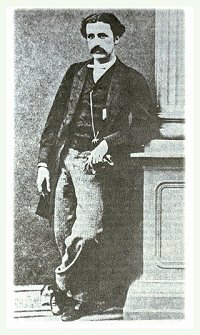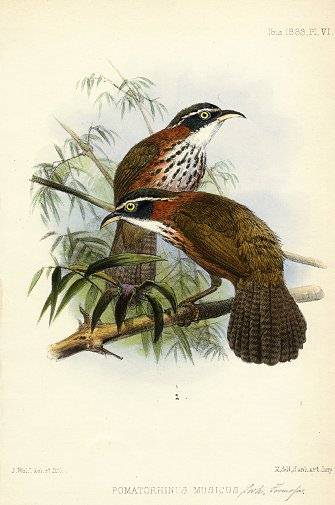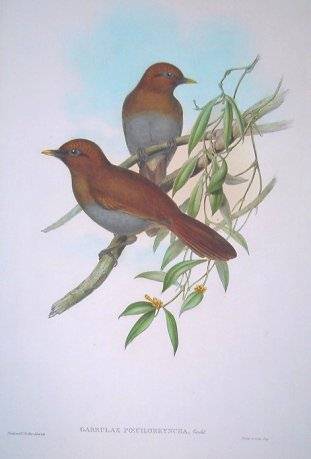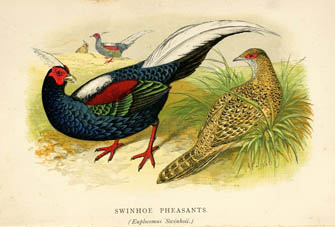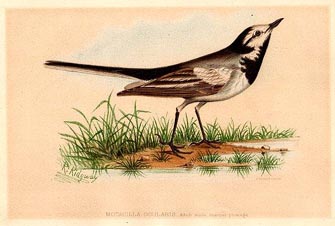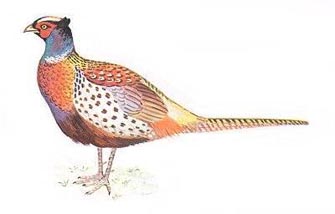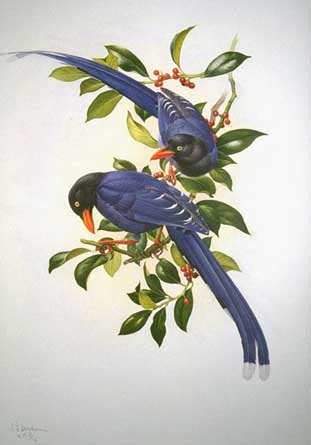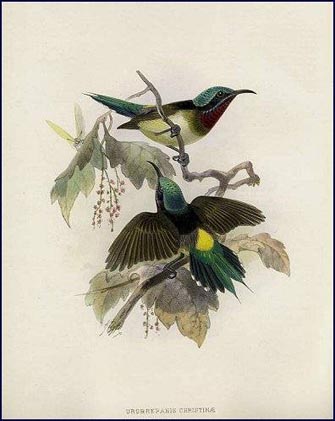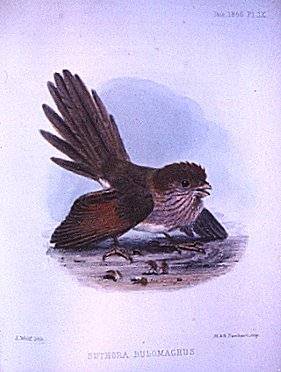|
|||||
|
Considered 'one of the most successful exploring naturalists that have ever lived', Robert Swinhoe resided at Takao in the 1860s. Swinhoe's prolific studies of wildlife on Taiwan have established his position not only as the instigator of the scientific study of the island's birds but also as a major contributor to the theory of evolution proposed by Darwin and Wallace. |
|||||
|
|||||
|
|||||
|
His most significant scientific research was carried out on the 'terra incognita' of Taiwan between the years 1856 and 1866. During a period of lengthy sojourns in Tamshui, Tainan and above all Takao (Kaohsiung), Swinhoe collected sufficient data to allow him to publish the first ever checklist of the birds of Taiwan and to name 227 species (including five endemic species) out of the 460 bird species, and 14 endemic species, now recorded on Taiwan. This site aims to acknowledge Robert Swinhoe as a famous historical resident of Takao (Kaohsiung) and links to more authoritative scientific and ornithological authorities can be found at the bottom of the page. However a partial appreciation of his work can be obtained through extracts of his writings and from some fine contemporary engravings given below. |
|||||
|
Engraving of Streak-breasted Scimitar Babbler (Pomatorhinus musicus) by Joseph Wolf. 'The Ibis' 1863. |
The first illustration (see left) of one of Swinhoe's discoveries, the Streak-breasted Scimitar Babbler
(Pomatorhinus musicus), appeared in 'The
Ornithology of Formosa' (The Ibis, 1863) . This bird, which is endemic to Taiwan, had first been recorded by Swinhoe during his 1858 voyage around the
island on board HMS Inflexible.
After an excursion at Su-ao Bay, Swinhoe wrote the following charming observations: "In every grove and plantation you are sure to find some of this species in small parties or in pairs ... collecting in a bush and chattering loudly together, or hopping from bough to bough, with rounded back and rounded, partially expanded tail. They have also ... affectionate manners toward one another, sidling together on a bough, and rubbing and pecking one another coaxingly....they breed twice, and sometimes thrice, during the summer....There is not much music in its ordinary call-note; but when two or three are met together and vie with one another in their strains, the effect is pleasing .... When at rest in the middle of the day, hidden in some sombre hill-side wood, they keep on uttering at intervals a series of very liquid notes in regular cadence. These have an indescribably hollow and unnatural sound, and at first puzzle the listener to know whether they are produced by beast, bird or insect...". |
||||
|
However, not all of Swinhoe's discoveries were named by him.
In the beginning Swinhoe would, as an amateur, send his samples and
specimens back to the United Kingdom for further confirmation and
identification by experts.
In particular, he sent many of his early specimens back to John Gould, a renowned taxidermist famous for his beautifully illustrated books, and a Fellow of the Royal Society in London. An example of this was the Grey-sided Laughing Thrush (Garrulax poecilorhynus) shown on the right in an illustration from Gould's 'Birds of Asia' published in 1864. This bird had been named by Gould in an article in the Proceedings of the Zoological Society in 1862 based on skins sent by Swinhoe. Swinhoe subsequently included the Garrulax poecilorhynus in an article in 'The Ibis' of 1863. |
Garrulax poecilorhynus or Grey-sided Laughing Thrush from J Gould's 'Birds of Asia' 1864 |
||||
| Perhaps the most famous of Swinhoe's discoveries was the Swinhoe Pheasant (Euplocamus swinhoii) which is an endemic species found (at that time) throughout the island from north to south but particularly prevalent in the middle part of the central mountain range. This bird was given the binomen Euplocamus swinhoii by Gould in 1862, with the specific name honouring its discoverer Swinhoe, adding "This exceedingly beautiful species is one of the most remarkable novelties I have had the good fortune to describe...In dedicating this fine bird to Mr. Swinhoe, I feel that I am only paying a just compliment to a gentleman who must ever rank among the foremost of those travellers who have enriched ornithology by their numerous eastern discoveries" | |||||
|
Euplocamus swinhoii or Swinhoe's Pheasant from a late 19th century engraving by A F Lydon |
Swinhoe's first published remarks on the Swinhoe Pheasant appeared in his 1863 article, The Ornithology of Formosa. Somewhat later, in a letter dated Takow, 1 June 1865, the naturalist throws more light on the way in which ornithologists worked at that time and writes that: "On the 6th of April my men rushed in with a fine old cock E. swinhoii. It was captured in the hills some eighty miles off, and only died the day before it reached me. It was in very good condition, but had lost a few of the maroon scapular feathers...The bare face-skin is of a much deeper and richer red than in Mr. Gould's plate, and is much more developed. The smaller figure in that plate gives the best idea of its appearance...I have sent several more of both sexes to Hongkong for |
||||
|
direct shipment. When disturbed in its cage, the bird utters a sound like 'has-sh', and ruffles up its feathers. It has also a chuckling note, chiefly uttered by the females. These are much more weakly than the cocks, and sooner succumb to fate." The White-eyed (or, Streak-eyed) Wagtail, Motacilla ocularis, is depicted on the right in a fine chromolithograph by Robert Ridgway, the leading American ornithologist in the late 19th and early 20th centuries. This bird was identified by Swinhoe during early 1860 in the region of Hong Kong. However, the Motacilla ocularis is a common winter visitor to southern and central Taiwan. |
Chromolithograph by Robert Ridgway of Motacilla ocularis or Streak-eyed Wagtail |
||||
|
Some of the difficulties in identifying birds, and particularly species can be illustrated by
the case of the Formosan Ring-necked Pheasant, Phasianus formosanus.
In his 1863 'Ibis' article entitled 'The Ornithology of Formosa', under the heading Phasianus torquatus, Swinhoe noted: "The Pheasant found throughout the plains and lower hills of Formosa is (almost) identical with the Chinese Pheasant". In 1866, back on the mainland at Amoy, he wrote: "The Formosan Ring-necked Pheasant differs from the typical Phasianus torquatus of China, ... but the variety is scarcely distinct enough to warrant my sending the birds home". |
|||||
|
Illustration of P.colchicus formosanus from ' A Field Guide to the Birds of Taiwan': Chang, James Wan-fu; Taipei, 1980. |
However, in the 9 June 1870 issue of the Zoological Society Proceedings D G Elliot described Swinhoe's specimens of the Formosan Ring-necked Pheasant as a new species, Phasianus formosanus. "This species, although undoubtedly of the same origin as the P. torquatus, has, from the physical causes operating upon it peculiar to its island home, (features) which makes it readily recognizable wherever seen ... (and) as binomial names are the only ones admissible, it becomes necessary to give it specific rank, rather than to describe it as a variety". In his 'A monograph of the Phasianidae, or family of pheasants', published in 1872, Elliot lists the 'true' Pheasants known to science, which, with the addition of the Formosan species, total nine. Today, with trinomial names, the Formosan Ring-necked Pheasant has reverted to be a sub-species, albeit endemic to Taiwan, of P. colchicus. |
||||
|
The stunningly beautiful illustration on the left shows the Formosan, or Taiwan Blue Magpie (Urocissa caerulea) as depicted by the Hong Kong born artist J Fenwick Lansdowne in the contemporary 'Rare Birds of China' series. The Taiwan Magpie was originally recorded by Swinhoe in 'The Ibis' in 1863 as the Long-tailed Mountain Nymph. This name is clearly derived from the local Taiwanese name meaning 'long-tailed mountain girl', which poetically describes the sight of this bird in flight as its tail feathers, tipped in white and making up half its length, flow behind it. This Blue Magpie is endemic to Taiwan and can be seen particularly in the hilly regions of the north of the island. However this brilliantly coloured bird, with sapphire blue plumage can be found at middle to low elevation throughout the island. A group of Formosan Blue Magpies in flight, which may be as large as 20 birds, is an unforgettable sight. |
Formosan Blue Magpie (Urocissa caerulea) by J Fenwick Lansdowne in the contemporary 'Rare Birds of China' series |
||||
|
Engraving of Mrs Swinhoe's Sunbird (Aethopyga christinae) by J. G. Keulemans from G. E. Shelley; A Monograph Of The Nectarindae, or family of Sunbirds. |
The final illustration that I have chosen, shown on the left, depicts not a bird seen on Taiwan but one that Swinhoe reported from his trip to Hainan Island, China, in 1868. This beautiful sun-bird was named by Swinhoe after his wife Christina as Mrs Swinhoe's Sunbird - Aethopyga christinae. Although its modern name is the Fork-tailed Sunbird, I have concurred with Mr Hall in reverting to the original one as a tribute to his wife. Christina Stronach was the daughter of the missionary Alexander Stronach of Foochow, China, and married Robert Swinhoe in 1862. It is believed that they had six children, including Robert A Swinhoe who was a tenor and later stage manager with the D'Oyly Carte Opera Company. Christina survived Swinhoe after his early death in 1877, and died in Brighton in 1914. There is some evidence that she accompanied Swinhoe on his postings as one child is recorded as being born in Takao. |
||||
|
|
|||||
|
As a footnote to this page, there is the charming tale of the feisty little Aidak. |
|||||
|
While in London in 1862-3 Swinhoe had recorded the observations of a Dutch missionary made at the time of the Dutch occupation of Formosa in the 17th century. The missionary noted how "a certain small bird called Aidak " was observed by the aborigines before they went to attack their enemies. "If this bird meets them flying with a worm in his bill, they take it for an infallible sign that they shall conquer their enemies. But if the bird flies from them, or pass them by, they are so much disheartened by the ill-omen, that they return home, and will not engage until they have better signs ... ". In December 1865, after his return to Formosa, Swinhoe spotted a caged bird unknown to him on his way from Taiwanfu to Takow. He subsequently obtained a similar bird and describes its behaviour as follows. "If one approached the cage he would begin shaking and quivering his wings, chirruping, and sidling towards the person. If the face were put down to the side of the cage, his agitation and the tremor of his wings would increase ... the Chinese of the interior call it 'Bang-taou' (lit. Netgamble), and prise it very highly for its pugnacious propensities". |
Illustration of Formosan Netgamble (Suthora bulomachus) by Joseph Wolf from The Ibis 1866 |
||||
| The bird is of course the Aidak and it caught Swinhoe's imagination, thinking that it was as an emblem for Formosa. He called it the Formosan Netgamble (Suthora bulomachus), but today it is known as the Vinous-throated Parrotbill (Paradoxornis webbianus bulomachus). | |||||
|
|
|||||
| Notes on Transliteration and Romanisation: Due to the changes in convention and political entities it is hard to find consistent spellings of place names. Thus: the spelling of modern day Kaohsiung may be rendered as Takow, Takau, Takao and now even Gaoxiong; that of modern day Tainan as Taiwan-foo or Taiwanfu; and that of Taiwan as Formosa. | |||||
|
The author would like to express his great appreciation to Mr Philip Hall for his kind and generous help and refer the reader to the following research : Y. Takahashi, 'Biography of Robert Swinhoe, 1836 - 1877', Quarterly Journal of the Taiwan Museum, Volume XVIII, 335-339, April 1935. Philip B. Hall, 'Robert Swinhoe ... A Victorian Naturalist in Treatyport China', Journal of the Royal Geographical Society, March 1987. |
|||||
|
|||||
|
|||||
